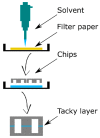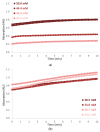Cyclic Olefin Copolymer Microfluidic Devices for Forensic Applications
- PMID: 31277382
- PMCID: PMC6784357
- DOI: 10.3390/bios9030085
Cyclic Olefin Copolymer Microfluidic Devices for Forensic Applications
Abstract
Microfluidic devices offer important benefits for forensic applications, in particular for fast tests at a crime scene. A large portion of forensic applications require microfluidic chip material to show compatibility with biochemical reactions (such as amplification reactions), and to have high transparency in the visible region and high chemical resistance. Also, preferably, manufacturing should be simple. The characteristic properties of cyclic olefin copolymer (COC) fulfills these requirements and offers new opportunities for the development of new forensic tests. In this work, the versatility of COC as material for lab-on-a-chip (LOC) systems in forensic applications has been explored by realizing two proof-of-principle devices. Chemical resistance and optical transparency were investigated for the development of an on-chip presumptive color test to indicate the presence of an illicit substance through applying absorption spectroscopy. Furthermore, the compatibility of COC with a DNA amplification reaction was verified by performing an on-chip multiple displacement amplification (MDA) reaction.
Keywords: UV-VIS spectroscopy; cyclic olefin copolymer; forensic science; illicit drug analysis; microfluidic device; polymer bonding; polymer surface functionalization; presumptive forensic test.
Conflict of interest statement
The authors declare no conflict of interest.
Figures







Similar articles
-
Rapid Manufacturing of Multilayered Microfluidic Devices for Organ on a Chip Applications.Sensors (Basel). 2021 Feb 16;21(4):1382. doi: 10.3390/s21041382. Sensors (Basel). 2021. PMID: 33669434 Free PMC article. Review.
-
Microfluidic Devices for Forensic DNA Analysis: A Review.Biosensors (Basel). 2016 Aug 5;6(3):41. doi: 10.3390/bios6030041. Biosensors (Basel). 2016. PMID: 27527231 Free PMC article. Review.
-
A practical approach for the optimization of channel integrity in the sealing of shallow microfluidic devices made from cyclic olefin polymer.Biomed Microdevices. 2018 Feb 24;20(2):24. doi: 10.1007/s10544-018-0265-9. Biomed Microdevices. 2018. PMID: 29478142
-
Isoelectric focusing in cyclic olefin copolymer microfluidic channels coated by polyacrylamide using a UV photografting method.Electrophoresis. 2005 May;26(9):1800-6. doi: 10.1002/elps.200410309. Electrophoresis. 2005. PMID: 15800962
-
Hydrophilic surface modification of cyclic olefin copolymer microfluidic chips using sequential photografting.J Sep Sci. 2007 May;30(7):1088-93. doi: 10.1002/jssc.200600515. J Sep Sci. 2007. PMID: 17566345
Cited by
-
Breaking the clean room barrier: exploring low-cost alternatives for microfluidic devices.Front Bioeng Biotechnol. 2023 Apr 27;11:1176557. doi: 10.3389/fbioe.2023.1176557. eCollection 2023. Front Bioeng Biotechnol. 2023. PMID: 37180035 Free PMC article. Review.
-
PCR-assisted impedimetric biosensor for colibactin-encoding pks genomic island detection in E. coli samples.Anal Bioanal Chem. 2021 Jul;413(18):4673-4680. doi: 10.1007/s00216-021-03404-6. Epub 2021 May 27. Anal Bioanal Chem. 2021. PMID: 34046698 Free PMC article.
-
Disposable DNA Amplification Chips with Integrated Low-Cost Heaters.Micromachines (Basel). 2020 Feb 25;11(3):238. doi: 10.3390/mi11030238. Micromachines (Basel). 2020. PMID: 32106462 Free PMC article.
-
Rapid Manufacturing of Multilayered Microfluidic Devices for Organ on a Chip Applications.Sensors (Basel). 2021 Feb 16;21(4):1382. doi: 10.3390/s21041382. Sensors (Basel). 2021. PMID: 33669434 Free PMC article. Review.
-
Engineering 3D Printed Microfluidic Chips for the Fabrication of Nanomedicines.Pharmaceutics. 2021 Dec 10;13(12):2134. doi: 10.3390/pharmaceutics13122134. Pharmaceutics. 2021. PMID: 34959415 Free PMC article.
References
-
- Tachibana H., Saito M., Tsuji K., Yamanaka K., Hoa L.Q., Tamiya E. Self-propelled continuous-flow PCR in capillary-driven microfluidic device: Microfluidic behavior and DNA amplification. Sens. Actuators B Chem. 2015;206:303–310. doi: 10.1016/j.snb.2014.09.004. - DOI
MeSH terms
Substances
LinkOut - more resources
Full Text Sources
Other Literature Sources
Miscellaneous

